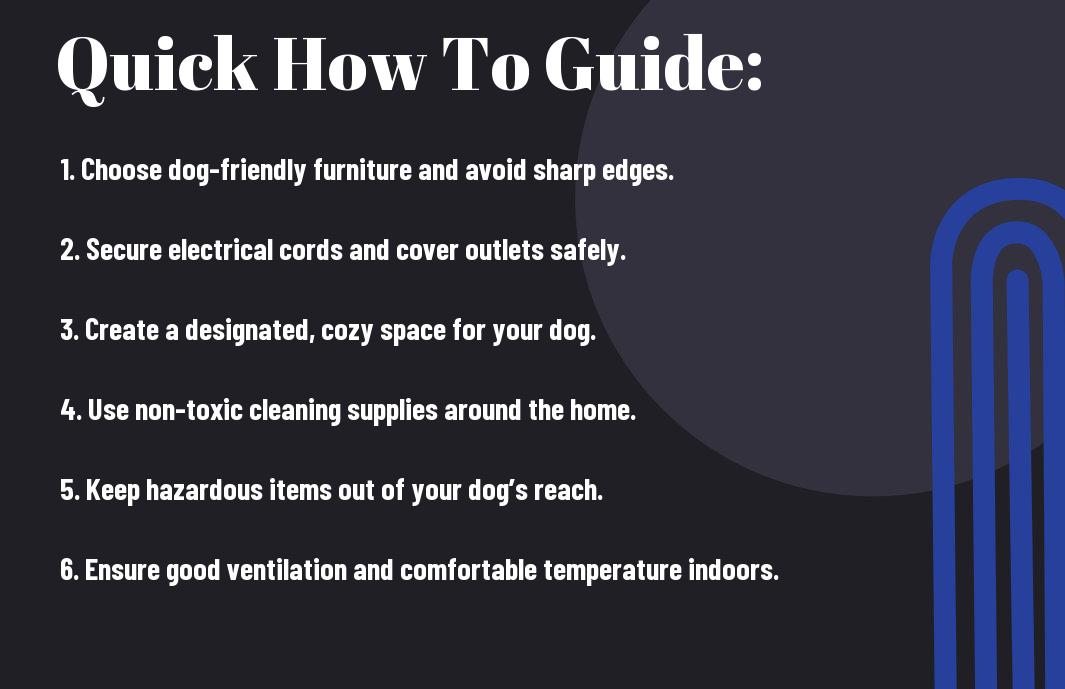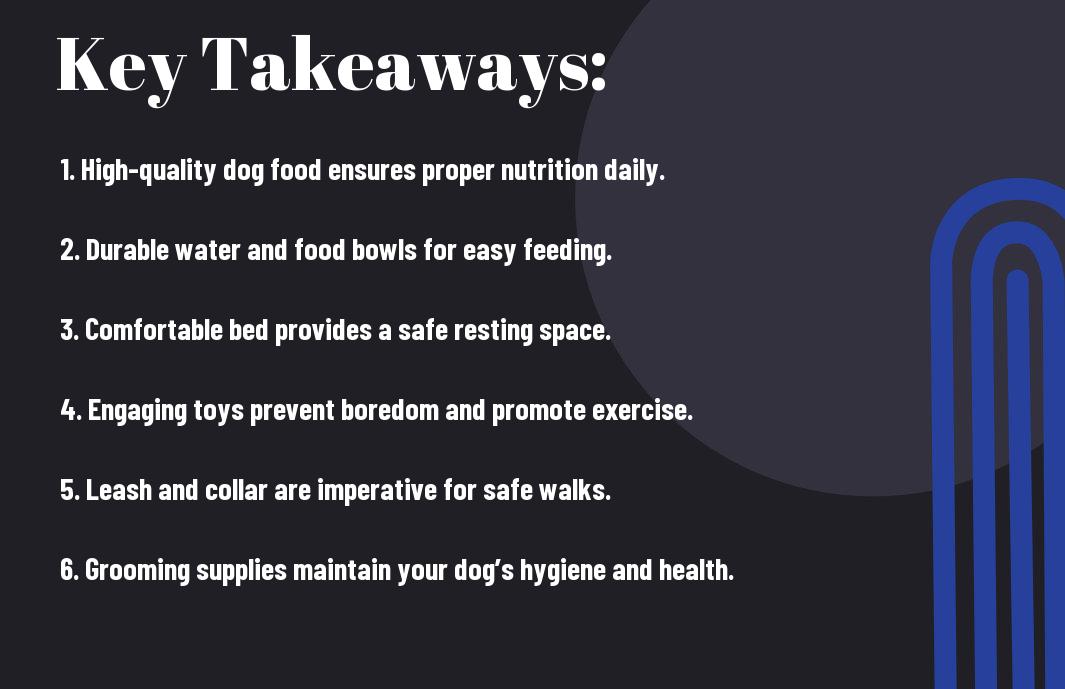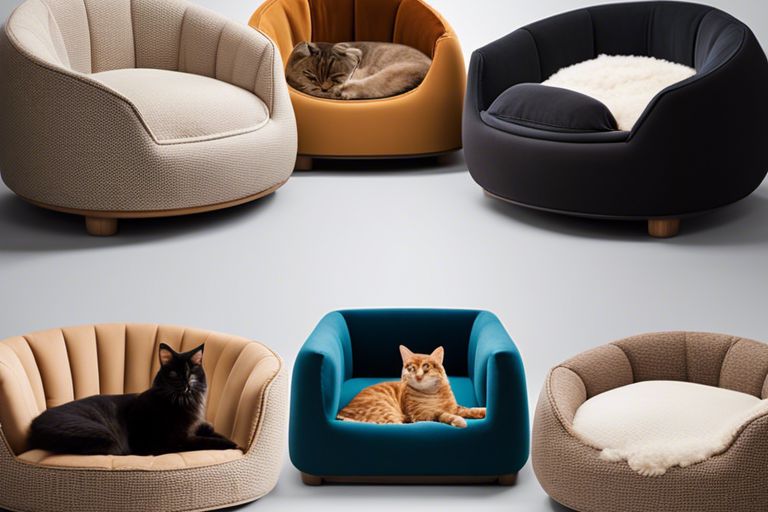You can transform your living space into a safe and comfortable environment for your dog with a few thoughtful adjustments. Start by identifying any potential hazards, such as toxic plants or accessible cords, that could harm your furry friend. Designate a cozy area with a quality bed, access to fresh water, and some favorite toys for relaxation. Regularly check for choking hazards and ensure your home is free from harmful substances. By fostering a nurturing atmosphere, you’ll not only enhance your dog’s well-being but also strengthen your bond with them.

Understanding Your Dog’s Needs
The success of creating a safe and comfortable home environment for your dog hinges on your understanding of their unique needs and characteristics. Each dog is an individual, and recognizing what makes your companion tick will significantly enhance their well-being. By taking the time to assess their temperament, identify safety concerns, and understand breed-specific needs, you position yourself to create a harmonious and nurturing space for them.
Assessing Your Dog’s Temperament
To truly understand your dog’s needs, it’s crucial to assess their temperament. Every dog has a distinct personality that shapes their behavior and reactions in various situations. You should observe how your dog interacts with people and other animals, their energy levels, and how they respond to stress or change. This awareness will not only help you create a more suitable environment but also enables you to engage in activities that foster a happy and fulfilled life for your pet.
Consider your dog’s level of sociability, whether they are shy or outgoing, and how they express affection or anxiety. If they thrive on human interaction, providing them with toys and activities that promote bonding can enhance their comfort at home. Conversely, if they are more reserved or anxious, offering a retreat area where they can feel safe can help navigate their feelings and make them feel secure in their environment.
Identifying Safety Concerns
Needs assessment goes beyond understanding temperament; it also requires identifying any safety concerns within your home environment. This means examining your space from your dog’s perspective—making adjustments to eliminate hazards they might encounter. Look for items like toxic plants, accessible breakable objects, or small items that could pose a choking risk.
It’s also important to consider areas of the home that might be off-limits for your dog. Ensuring that hazardous materials, such as cleaning products or medicines, are securely stored can prevent accidents. A close inspection of your home will help you create a safe sanctuary where your dog can thrive without the risk of harm.
Understanding Breed-Specific Needs
Needs vary significantly between different dog breeds, and understanding these breed-specific needs can greatly enhance your dog’s life. Each breed has its own particular characteristics that influence their habits, exercise requirements, and emotional needs. Researching the specific traits associated with your dog’s breed will allow you to tailor your home to foster their well-being.
For instance, high-energy breeds often require ample space to roam and engage in physical activity, while others may have more relaxed dispositions, enjoying mental stimulation through puzzle toys. Acknowledging these traits can guide you in providing an environment that is conducive to their natural instincts and behaviors, ensuring your dog feels secure and happy in their surroundings.
A deeper explore breed-specific needs will reveal critical insights regarding health implications, grooming necessities, and training approaches that work best for your dog. By aligning these factors with your daily routine, you can cultivate a nurturing home that caters directly to your dog’s unique needs.
Creating a Safe Space
While your dog loves being around you, it’s equally important for them to have a space where they can feel safe and secure. This area becomes their retreat, where they can relax, unwind, and escape from the hustle and bustle of daily life. Creating a safe space can help reduce anxiety, provide a sense of ownership, and allow your dog to recharge when needed.
Selecting the Right Location
With so many options for your dog’s safe space, choosing the right location is imperative. Look for a quiet area in your home, away from high traffic zones and loud noises. This could be a corner of a room or a cozy spot in your living area that feels peaceful. It’s important that your dog can easily access this space, especially during moments when they need to retreat from potential stressors.
Additionally, consider the temperature of the area you’ve selected. A space that is not too hot or too cold will help your dog feel more comfortable. Make sure to avoid areas exposed to drafts or direct sunlight, which could create an uncomfortable environment. By taking the time to choose the right location, you can ensure your dog has a secure and pleasant place in your home.
Dog-Proofing Your Home
You will also want to ensure that your home is safe for your dog by implementing some dog-proofing measures. Start by identifying any potential hazards, such as electrical cords, toxic plants, or items that could be easily knocked over and cause injury. Make sure to keep cleaning products and medications out of reach, as these can be highly dangerous if ingested. It’s also wise to barricade any areas or rooms that you don’t want your dog to access.
Right after you dog-proof, it’s time to assess your furniture and fixtures. Remove or secure any small items like decorative objects or fragile items that your dog might be tempted to chew or knock over. You may also want to consider using corner protectors for furniture with sharp edges or blocking off areas where your dog may get stuck or injured. By taking these preventive steps, you create a secure environment for your furry friend.
Creating a Comfortable Sleeping Area
Comfortable sleeping is imperative for your dog’s overall well-being. Designate a specific area in your home where your dog can retreat to rest. This space should be inviting and cozy, equipped with a soft dog bed or blanket, which will give your dog a sense of security. Consider placing a few toys nearby to make the area more enjoyable and engaging for them.
Space is also vital when creating this area. Ensure it is large enough for your dog to stretch out fully but not so large that it feels exposed. If your dog has a favorite blanket or piece of clothing that smells like you, consider placing that in their sleeping area to help them feel more connected and at ease. A comfortable sleeping area contributes significantly to your dog’s happiness and stress relief.
Maintaining a Clean Environment
To create a safe and comfortable home environment for your dog, it is necessary to prioritize cleanliness. This ensures not only your pet’s health and well-being but also contributes to a more pleasant living space for you and your family. A clean home minimizes the risk of diseases and infections, while also preventing the development of fur and odor buildup that can negatively impact your dog’s happiness. By establishing routines and utilizing the right products, you can efficiently maintain a tidy space that is enjoyable for both you and your pet.
Choosing Dog-Friendly Cleaning Products
Clearly, selecting the right cleaning products is imperative when you have a dog in your home. Many conventional cleaning agents contain harsh chemicals that can be dangerous to your furry friend. Products that contain ammonia, bleach, or other harmful substances can cause respiratory issues or skin irritations in dogs. Therefore, it’s necessary that you opt for non-toxic, pet-safe cleaning solutions that effectively eliminate dirt while also being gentle on your pet’s sensitive system.
Additionally, there are numerous eco-friendly cleaning options available, which not only safeguard your dog’s health but also contribute positively to the environment. Look for products that advertise themselves as biodegradable and free from harmful chemicals, ensuring your cleaning routine aligns with both your values and your dog’s safety. When unsure about a product, a simple test for harmful ingredients or looking for third-party certifications can provide guidance in making a safe choice.
Establishing a Regular Cleaning Schedule
Little by little, establishing a cleaning schedule can keep your home in tip-top shape and make it easier to manage your dog’s messes. Consistency is key; setting aside time each week for deep cleaning ensures that fur, dander, and potential allergens are minimized. Break down tasks into manageable portions, such as vacuuming, mopping, and wiping down surfaces, so it doesn’t feel overwhelming. By incorporating cleaning into your regular routine, you will cultivate a cleaner and healthier environment for your dog.
Products you choose to use during these cleaning sessions should be effective yet safe for both you and your dog. Prioritize tools like vacuum cleaners with strong filtration systems to trap allergens and remove pet hair efficiently. A simple checklist can help you streamline your efforts each week, making it easy to stay on top of the cleaning tasks necessary to ensure a pleasant living environment for everyone.
Managing Pet Odors
Products designed for odor removal can make a significant difference in maintaining a fresh-smelling home. Natural enzyme cleaners are particularly effective at breaking down the sources of unpleasant smells, be it from urine, feces, or simply your dog’s natural scent. Additionally, using air purifiers with HEPA filters can help remove dander and allergens, further improving air quality in your space.
Another proactive approach involves regularly washing your dog’s bedding, toys, and any items they frequently come into contact with. This not only helps control odors but also keeps your dog’s environment hygienic. Additionally, consider implementing odor-neutralizing sprays that are safe for pets, ensuring a fresher atmosphere in your home. By effectively managing pet odors, you foster a comfortable environment that benefits both you and your dog.

Providing Comfort and Enrichment
Many dog owners may overlook the importance of creating a comfortable and engaging environment for their furry friends. A well-designed space not only enhances your dog’s physical well-being but also supports their mental and emotional health. By focusing on comfort and enrichment, you can ensure your home is a haven that encourages relaxation and play, contributing to a happier life for your pet.
Choosing Appropriate Furniture
Any furniture you choose for your home should prioritize your dog’s needs. Consider investing in dog-friendly materials that are easy to clean and resistant to wear and tear. Opt for durable fabrics that can withstand the occasional scratch or slobber. Additionally, think about incorporating a dog bed that offers proper support for your pet’s joints, particularly if they are older or have specific health concerns.
Another factor to consider is the layout of your living space. Create designated areas where your dog can rest without disturbances. This might mean placing their bed in a quiet corner, away from heavy foot traffic, or ensuring that your seating arrangements allow your dog to feel included while still having their own space.
Providing Interactive Toys
For enhancing your dog’s mental stimulation, providing interactive toys is crucial. These toys keep your pet engaged and can help alleviate boredom, which may otherwise lead to destructive behaviors. Look for toys that challenge your dog’s problem-solving skills, such as puzzle feeders and treat-dispensing gadgets. Invest in a variety of toys that cater to different play styles, ensuring that your dog has options that match their preferences.
Comfort is also key when considering toys, so observe which ones your dog tends to gravitate towards and ensure they are made from safe materials. Interactive toys often include squeakers or crinkle sensors that can make playtime more enjoyable. Regularly rotate your dog’s toys to keep their interest piqued, and observe their reactions to introduce new toys that could enhance their play experience.
Creating an Outdoor Space
One of the best ways to provide comfort and enrichment is by developing a safe and enjoyable outdoor space for your dog. This area should be securely fenced to prevent escapes, catering to your pet’s natural instincts while ensuring their safety. Incorporate elements that allow for exploration and play, such as a designated digging area, plenty of room to run, and options for games like fetch. Make sure to provide shaded areas where your dog can relax away from the heat, especially during warmer months.
Additionally, you can enhance this outdoor space by adding sensory elements like different textures underfoot, such as grass, gravel, or sand, and even planting dog-friendly flowers for a visually stimulating environment. These features not only enrich your dog’s experience outside but also create a calming setting where they can unwind and enjoy the fresh air.
Providing a thoughtful environment filled with comfort and interactive opportunities leads to a happier, more fulfilled pet. By making adjustments to your home and outdoor spaces, you’re not just ensuring your dog’s physical safety, but also enriching their lives with joy and stimulation.

Building a Routine
Now that you’ve created a safe and comfortable home environment for your dog, establishing a routine is the next imperative step. A predictable schedule helps your dog feel secure and reduces anxiety. It ensures that they know what to expect, which can be particularly helpful in managing their behavior and creating a lasting bond between you and your furry friend.
Establishing Feeding Times
To begin with, setting regular feeding times is imperative for your dog’s well-being. Consistent meal schedules not only promote better digestion but also help regulate your dog’s appetite. Aim for two to three meals a day, depending on your dog’s age and dietary needs, and always ensure fresh water is available throughout the day.
Additionally, feeding your dog at the same times each day helps them learn when to expect food, which can prevent begging or scrounging for scraps. This structure not only keeps your dog healthy but also enhances your communication and understanding of their needs.
Scheduling Play and Exercise
Building a regular play and exercise schedule is vital for your dog’s physical and mental health. Dogs require daily exercise to expend energy and maintain a healthy weight. Depending on the breed, age, and energy level of your dog, you should aim for at least 30 minutes to 2 hours of activity each day. Incorporating walks, fetch, or even interactive play sessions can be beneficial for strengthening your bond.
Routine exercise not only improves your dog’s fitness but can also alleviate behavioral issues stemming from boredom. Organizing playtime at consistent intervals will help your dog understand when it is time to be active, making them more relaxed during other parts of the day.
Routine exercise is just as important for you as it is for your dog. Participating in these activities creates a balanced lifestyle and fosters a stronger connection with your pet. It’s an opportunity to enjoy the outdoors together while bolstering your dog’s overall happiness.
Creating a Calm Environment
Building a calm atmosphere in your home is vital for your dog’s mental well-being. Dogs thrive in environments that are peaceful and free from excessive noise or chaos. Setting specific areas where your dog can rest or retreat during stressful situations can help them feel safe. Consider creating a cozy corner with their bed, blankets, and favorite toys to encourage relaxation.
In addition to providing a safe space, ensuring that your home is free of loud noises, sudden movements, and stressful stimuli will help your pooch feel at ease. This will also reflect positively on their behavior, making them more balanced and less anxious.
Understanding the elements of a calm environment means being mindful of factors that might disrupt your dog’s peace. Keeping the space tidy and minimizing clutter creates a serene atmosphere, helping your dog relax and adapt better to the routines you’ve established.
Monitoring Health and Well-being
Unlike humans, dogs cannot express their discomfort or health issues verbally, making it vital for you to monitor their health and well-being closely. A comfortable home environment means actively observing and understanding your dog’s needs, making regular health assessments a part of your routine. By being vigilant, you can detect potential problems early on, ensuring your dog remains happy and healthy.
Regular Veterinary Check-ups
Regular veterinary check-ups are crucial in maintaining your dog’s overall health. These appointments allow your veterinarian to perform comprehensive health assessments and vaccinations, providing peace of mind for you. At each visit, your vet will check for common issues such as weight, dental health, and skin conditions, helping to prevent minor problems from escalating into major health concerns.
In addition to routine examinations, your vet can offer personalized advice tailored to your dog’s breed, age, and lifestyle. Addressing any health queries you might have is part of these visits, so be sure to clarify any concerns about your dog’s well-being. Your proactive approach at these appointments will significantly contribute to your dog’s long-term health.
Observing Behavioral Changes
To keep your dog healthy, it’s crucial to observe any behavioral changes that may occur over time. Sudden shifts in activity levels, eating habits, or social interactions can be indicators of underlying health problems. Pay attention to how your dog behaves and note any deviations from their normal routine. For instance, if your normally playful dog becomes lethargic or withdraws from interaction, consider this a red flag that requires further investigation.
Changes in your dog’s behavior could stem from various factors, including stress, pain, or illness. By monitoring these changes closely, you can act quickly, providing your veterinarian with detailed observations that may aid in diagnosis and treatment. Early detection is key to addressing any potential health issues, ultimately enhancing your dog’s quality of life.
Nutrition and Diet Factors
With a balanced diet, you can significantly improve your dog’s health and well-being. Understanding the importance of nutrition is crucial; the quality of food you provide directly influences their energy levels, coat condition, and overall vitality. Aim for well-rounded meals that meet your dog’s specific needs based on their breed, age, and any health concerns. Adequate hydration is equally important, so always ensure your dog has access to fresh water.
- Healthy weight management is vital in preventing issues like obesity, which can lead to serious health problems.
- High-quality ingredients should be prioritized in your dog’s diet to promote optimal health and wellness.
- Allergies are common in dogs; keep an eye on your dog’s diet to prevent potential allergic reactions.
Plus, consider consulting your vet for recommendations on the best type of food for your pet’s unique needs. Factors such as their activity level and any medical conditions should be taken into account to ensure they receive nutritional support tailored to them. Familiarizing yourself with the signs of nutritional deficiencies will help you make better dietary choices for your dog. Perceiving these factors helps ensure your dog remains healthy and energetic.
- Protein sources must be high-quality, promoting muscle health and maintenance.
- Fats are crucial for energy, but be cautious of the quantities you offer to prevent obesity.
- Vitamins and minerals support various bodily functions, so choose a diet that includes crucial micronutrients.
By keeping these nutrition and dietary elements in mind, you lay the foundation for a long and healthy life for your furry friend. Perceiving changes in your dog’s health relating to diet can lead to important adjustments that foster their overall well-being.
Final Words
So, creating a safe and comfortable home environment for your dog is a rewarding endeavor that enhances your pet’s well-being and your overall bond. Start by assessing your living space for any potential hazards, such as exposed wires or toxic plants, and take the necessary steps to eliminate these risks. Providing a designated area with a cozy bed and familiar toys not only gives your dog a sense of security but also helps in establishing good behavior patterns. Additionally, ensure that your home maintains a consistent temperature and is well-ventilated, as this can significantly affect your dog’s comfort level.
Your dog’s mental stimulation is equally important, so consider incorporating interactive toys or setting aside time for training sessions to keep their mind sharp. Socialization opportunities—whether it’s through playdates or visits to the park—can also help your furry friend feel more relaxed and engaged. By prioritizing these aspects, you create an environment where your dog feels safe, loved, and content, ultimately leading to a happier life for both of you.
FAQ
Q: What are some imperative steps to ensure my home is dog-proof?
A: Dog-proofing your home involves taking several steps to prevent accidents and ensure your dog’s safety. First, identify areas where your dog could get into trouble, such as kitchens and bathrooms, and secure hazardous items like cleaning supplies and sharp objects. Store household chemicals in high cabinets or locked areas. Additionally, use baby gates to limit access to certain rooms and remove small items that could be swallowed. Ensure electrical cords are tucked away and furniture is arranged to avoid any potential hazards.
Q: How can I create a comfortable space for my dog in my home?
A: To create a comfortable space, start by designating a specific area for your dog, such as a cozy dog bed or crate in a quiet part of the house. Make sure their space is away from noisy appliances and high-traffic areas. Provide comfort items, like blankets or toys, to make the space inviting. Ensure that the temperature in the area is suitable and adjust ventilation if needed. You can also consider adding a pet-friendly rug to absorb water or dirt, making cleanup easier and providing a warm spot for your pet to rest.
Q: What should I consider for my dog’s mental and physical stimulation at home?
A: Keeping your dog mentally and physically engaged while at home is important for their overall well-being. Incorporate interactive toys or puzzles that challenge their mind, and set aside time each day for play or training sessions. Regular walks or playdates with other dogs can also help fulfill their physical activity needs. Consider designing a play space where they can safely explore, and take advantage of safe indoor games that encourage movement. Lastly, rotating toys can keep their interest alive and provide new challenges to stimulate their minds regularly.










